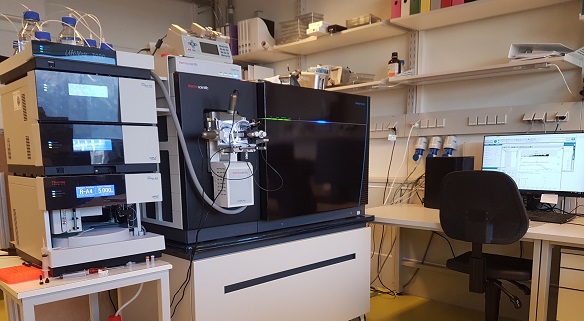Electrospray Ionization Mass Spectrometry (ESI-MS)
Equipment:
Orbitrap Eclipse FAIMS Pro and Q Exactive HF (ThermoScientific) equipped with an ESI/nanospray interface and coupled to an UltiMate 3000 system for LC-Micro, Ultimate 3000 RSLC for LC-Nanospray (Dionex) and CESI 8000 for CE-MS (Beckman).
Method:
The analyte is introduced to the source in solution either from a syringe pump or as the eluent flow from liquid chromatography. Flow rates are typically of the order of 1-10µL/min for ESI, 200-500nL/min for nanospray MS and 10-150nL/min for CE-MS. Sample molecules move through a high-voltage gradient which forms a fine mist of electrically charged droplets. The sample ions are then transferred from solution into the gas phase via solvent evaporation. It is a very soft method of ionisation, thus little or no fragmentation of sample molecules occurs. Structural and sequence information is obtained by tandem MS (MS/MS), where usually two mass analysers are separated by a collision cell into which an inert gas (e.g. helium) is admitted to collide with selected sample ions and bring about their fragmentation.
The Q Exactive HF is well-suited for the analysis of complex protein mixtures as it provides superior mass accuracy for lower false positive rates, high sensitivity and dynamic range leading to more protein identifications, parallel acquisition mode for optimized productivity and excellent MS/MS sensitivity. Therefore, this instrument is especially well-suited for the identification of PTMs.
Provided Services:
- Comprehensive protein identification of simple and complex protein digests from gel bands, immunoprecipitations (IP), and whole-cell/tissue digests by mass spectrometry
- Molecular mass determination of intact proteins or peptides
- Localization and quantification of post-translational modifications (phosphorylation, acetylation, methylation, deamidation, citrullination, etc.)
- Mass spectrometry supported determination of protein complex structure by identification of chemical cross-linked peptides
- Enrichment of phosphopeptides by Immobilized Metal Affinity Chromatography (IMAC, TiO2 etc.)
- Quantitative Proteomics using isotope labelling strategies (e.g., SILAC, iTRAQ, TMT, etc.)
- Lable free Quantification
- Chemical derivatization of proteins for the identification of the N- and C-terminal amino acid sequence
- Identification and quantification of complex protein mixtures applying data-dependent (DDA) and data-independent acquisition (DIA)
- Quantitative polyamine analysis
- Capillary electrophoresis-electrospray ionization-mass spectrometry (CESI-MS)
- Quantification of nucleotide/nucleoside-type molecules without derivatization using CESI-MS
Sample Preparation:
-
Bands on the gel may be visualized by Coomassie, DIGE, Sypro or silver. Generally we recommend Coomassie stains over silver stains due to higher compatibility with mass spectrometry. If silver stain must be used an MS-compatible protocol (avoiding glutaraldehyde) for silver staining can be downloaded here.
-
You may either send the whole gel with the bands clearly marked and we will cut them out or you can excise the bands of interest and send them in a vial. Optimum thickness for gels is 1 mm. It is desirable to use the narrowest gel lane width possible to achieve protein to gel volume ratio as high as possible.
-
Sample handling: Keratin contamination will always be observed so extra precautions must be taken to minimize the amount of this contamination as it can interfere protein characterization to a very large extent! A protocol can be downloaded here.
-
Volatile buffers, e.g. ammonium acetate and ammonium formate, should be used (maximum concentration: 50mM). Detergents must be removed. All known chemicals in the solution should be listed in the submission form. Use the smallest vial necessary. Keep in mind, that during protein purification, or lyophilisation cheap plastic ware or low quality solvents stored in plastic cans can contaminate your sample with plasticizers (polymeric material), which can be retained during chromatographic purification and reduce the yield of peptides, or make the analysis completely impossible.
In general:
-
All samples must be accompanied with a completed sample submission form.
-
Users are encouraged to discuss specific questions with facility members before submitting samples.
-
Estimated turnaround times: Ten business days
All values of turnaround times stated are averages for single sample submission.
Fees for ESI:
For further details and price, please contact us via “e-mail”




